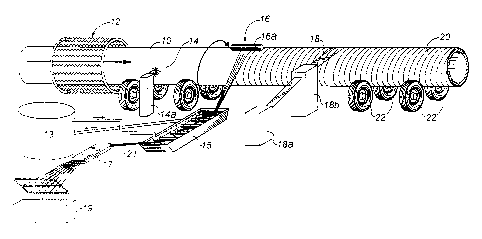Some of the information on this Web page has been provided by external sources. The Government of Canada is not responsible for the accuracy, reliability or currency of the information supplied by external sources. Users wishing to rely upon this information should consult directly with the source of the information. Content provided by external sources is not subject to official languages, privacy and accessibility requirements.
Any discrepancies in the text and image of the Claims and Abstract are due to differing posting times. Text of the Claims and Abstract are posted:
| (12) Patent Application: | (11) CA 2329444 |
|---|---|
| (54) English Title: | PIPE COATING PROCESS |
| (54) French Title: | PROCESSUS DE REVETEMENT DE TUYAU |
| Status: | Deemed Abandoned and Beyond the Period of Reinstatement - Pending Response to Notice of Disregarded Communication |
| (51) International Patent Classification (IPC): |
|
|---|---|
| (72) Inventors : |
|
| (73) Owners : |
|
| (71) Applicants : |
|
| (74) Agent: | THOMPSON LAMBERT LLP |
| (74) Associate agent: | |
| (45) Issued: | |
| (22) Filed Date: | 2000-12-21 |
| (41) Open to Public Inspection: | 2002-06-21 |
| Examination requested: | 2002-11-29 |
| Availability of licence: | N/A |
| Dedicated to the Public: | N/A |
| (25) Language of filing: | English |
| Patent Cooperation Treaty (PCT): | No |
|---|
| (30) Application Priority Data: | None |
|---|
Resin soaked fiberglass strands are applied to abrasively cleaned steel pipe
to
increase the hoop stress. Steel pipe that is abrasively cleaned is preheated
and a primer coat
is applied. Fiberglass strands that are soaked with heated resin are then
applied in a helical
method to the pipe to induce an accelerated cure of the resin. Followed by a
polyethylene
wrap to protect the ouside of the composite. Allowing the coated pipe to be
driven over a
conveyor line. This process is continuous in which the steel pipe is wrapped
from end to
end, on pipe that is connected with a come-along (steel or plastic).
Note: Claims are shown in the official language in which they were submitted.
Note: Descriptions are shown in the official language in which they were submitted.

2024-08-01:As part of the Next Generation Patents (NGP) transition, the Canadian Patents Database (CPD) now contains a more detailed Event History, which replicates the Event Log of our new back-office solution.
Please note that "Inactive:" events refers to events no longer in use in our new back-office solution.
For a clearer understanding of the status of the application/patent presented on this page, the site Disclaimer , as well as the definitions for Patent , Event History , Maintenance Fee and Payment History should be consulted.
| Description | Date |
|---|---|
| Inactive: IPC from MCD | 2006-03-12 |
| Inactive: IPC from MCD | 2006-03-12 |
| Application Not Reinstated by Deadline | 2005-12-21 |
| Time Limit for Reversal Expired | 2005-12-21 |
| Deemed Abandoned - Failure to Respond to Maintenance Fee Notice | 2004-12-21 |
| Letter Sent | 2002-12-16 |
| Request for Examination Received | 2002-11-29 |
| All Requirements for Examination Determined Compliant | 2002-11-29 |
| Request for Examination Requirements Determined Compliant | 2002-11-29 |
| Inactive: Cover page published | 2002-06-21 |
| Application Published (Open to Public Inspection) | 2002-06-21 |
| Inactive: IPC assigned | 2001-03-30 |
| Inactive: First IPC assigned | 2001-03-30 |
| Inactive: IPC assigned | 2001-03-29 |
| Filing Requirements Determined Compliant | 2001-01-31 |
| Inactive: Filing certificate - No RFE (English) | 2001-01-31 |
| Application Received - Regular National | 2001-01-30 |
| Abandonment Date | Reason | Reinstatement Date |
|---|---|---|
| 2004-12-21 |
The last payment was received on 2003-12-11
Note : If the full payment has not been received on or before the date indicated, a further fee may be required which may be one of the following
Please refer to the CIPO Patent Fees web page to see all current fee amounts.
| Fee Type | Anniversary Year | Due Date | Paid Date |
|---|---|---|---|
| Application fee - standard | 2000-12-21 | ||
| MF (application, 2nd anniv.) - standard | 02 | 2002-12-23 | 2002-11-29 |
| Request for examination - standard | 2002-11-29 | ||
| MF (application, 3rd anniv.) - standard | 03 | 2003-12-22 | 2003-12-11 |
Note: Records showing the ownership history in alphabetical order.
| Current Owners on Record |
|---|
| GLEN R. GARNEAU |
| Past Owners on Record |
|---|
| None |